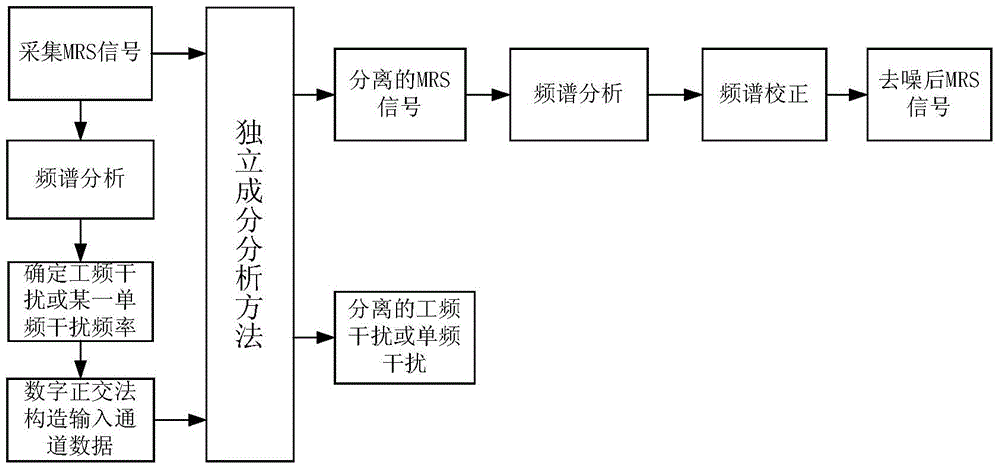Full-wave nuclear magnetic resonance signal denoising method based on independent component analysis
A technology of independent component analysis and nuclear magnetic resonance, applied in electron magnetic resonance/nuclear magnetic resonance detection, acoustic re-radiation, electric/magnetic exploration, etc., can solve problems affecting engineering progress, underdetermined blind source separation, and limit ICA applications and other problems, to achieve the effect of saving manpower and material resources, reducing information loss, and fast computing speed
- Summary
- Abstract
- Description
- Claims
- Application Information
AI Technical Summary
Problems solved by technology
Method used
Image
Examples
Embodiment 1
[0105] This embodiment is a simulation experiment of the method of the present invention carried out under the MATLAB 7.0 programming environment.
[0106] The simulation algorithm of the full-wave NMR signal noise filtering method based on independent component analysis, refer to figure 1 , including the following steps:
[0107] Step (1): Use formula (10) to construct the Larmor frequency is 2325Hz, amplitude e 0 150nV, the relaxation time is an ideal MRS signal of 0.15s, as shown in Figure 4(a), and Figure 4(b) is its corresponding spectrum. Add 2350Hz and 2300Hz power frequency interference near the Larmor frequency of the signal, and form an observed MRS signal X with a signal-to-noise ratio of -6.7471dB through a certain linear combination 1 (t) (for a row vector), as shown in Figure 5(a);
[0108] Step (2): Observing the MRS signal X 1 (t) Perform Fourier transform to obtain its frequency spectrum, as shown in Fig. 5(b). Determine the frequency of the power frequ...
Embodiment 2
[0115] In this embodiment, the MRS signals collected in Shaoguo Town, Changchun City (the Delamor frequency is 2326 Hz) are used as the processing object of the method of the present invention. Such as figure 1 As shown, the full-wave NMR signal noise filtering method based on independent component analysis includes the following steps:
[0116] Step (1): Collect a set of observed MRS signals X using the nuclear magnetic resonance sounding (MRS) water detector 1 (t) (be a row vector), as shown in Figure 8 (a), calculate its signal-to-noise ratio as SNR=-4.9186dB;
[0117] Step (2): For the collected observed MRS signal X 1 (t) Perform Fourier transform to obtain its spectrum, as shown in Figure 8(b), it can be seen that the signal is at f 0 =2300Hz, f 1 =2350Hz, f 2 = 2450Hz has strong power frequency harmonic interference, in addition, at f 3 = Strong single-frequency interference at 2383.5Hz;
[0118] Step (3): According to the noise frequency determined in step (2), ...
PUM
 Login to View More
Login to View More Abstract
Description
Claims
Application Information
 Login to View More
Login to View More - R&D
- Intellectual Property
- Life Sciences
- Materials
- Tech Scout
- Unparalleled Data Quality
- Higher Quality Content
- 60% Fewer Hallucinations
Browse by: Latest US Patents, China's latest patents, Technical Efficacy Thesaurus, Application Domain, Technology Topic, Popular Technical Reports.
© 2025 PatSnap. All rights reserved.Legal|Privacy policy|Modern Slavery Act Transparency Statement|Sitemap|About US| Contact US: help@patsnap.com



